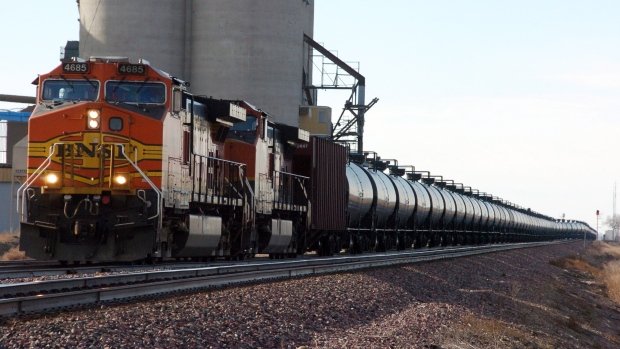Oct 6, 2017
Crude-by-rail reliance expected to increase after Energy East cancellation
, Reuters

CALGARY — TransCanada Corp's (TRP.TO) decision this week to scrap its US$12-billion Energy East pipeline and delays to other export pipeline projects look set to increase producers' reliance on costly crude-by-rail to bring barrels to market.
Calgary-based TransCanada said on Thursday it will abandon Energy East, which would have taken crude from Alberta to the Atlantic Coast. The move came after the National Energy Board (NEB) on Aug. 23 announced a tougher review process that would consider indirect greenhouse gas emissions.
Shipping crude by rail is more expensive than by pipeline for producers already struggling with weak global oil prices. It is also considered more dangerous than pipelines because of derailments like the 2013 Lac-Megantic, Quebec, disaster, in which 47 people died in a fiery oil train crash.
Oil industry participants say regulatory requirements for major energy projects in Canada are now so stringent it is unlikely any company will try to build a new export pipeline. A global oil market slump has also diminished appetite for building multibillion-dollar pipelines.
That means that Canada's increasing production of crude, expected to temporarily outpace pipeline space over the next two years, could face a longer-term lack of pipeline capacity and subsequent lower prices if crude becomes bottlenecked in Alberta.
While pipeline congestion is bad news for producers, it will prove a boon for rail terminal operators who were badly burned when oil prices — and crude-by-rail volumes — crashed in 2014.
Privately-held TORQ Transloading expects to move up to 20,000 barrels per day of crude by rail next year, a threefold increase over 2017.
"We have seen a pickup in activity and heightened interest as we move into next year. Some people are signing contracts and there's just more spot movement," Chief Executive Jarrett Zielinski said in an interview on Friday.
A rail revival could also result in tens of thousands of barrels per day of idle loading capacity, like that at the Hardisty, Alberta, terminal operated by U.S. Development Partners LP and Gibson Energy, being used.
In June, USD Partners signed a three-year contract with a customer to ship 30,000 bpd of Canadian crude to Oklahoma, starting in October.
Analysts are expecting a surge in crude-by-rail exports later this year as two major oil sands projects in northern Alberta add 270,000 bpd to Canada's current 3.85 million bpd of production.
How long that rail boom lasts will depend on whether the three export pipeline projects currently being developed - Kinder Morgan Canada's (KML.TO) Trans Mountain, Enbridge Inc's Line 3 and TransCanada's Keystone XL — are further delayed by environmental opposition and legal challenges.
Tudor Pickering Holt analysts estimate Canadian crude-by-rail volumes will rise from less than 200,000 bpd in early 2018 to a peak of around 550,000 bpd in 2019, when the Trans Mountain and Line 3 expansions are scheduled to start operating.
Transporting crude by rail costs more than by pipeline, around US$11-US$14 a barrel versus US$7 a barrel, and persistently low global crude prices mean some producers will struggle with the higher costs if pipeline delays drag on.
"If it looks like Trans Mountain could get delayed for years people will start to reconsider their approach as the cost of rail in the current price environment means it is really hard for producers to make a return," said Morningstar analyst Sandy Fielden, adding some producers may shut in production.
To be sure, if Trans Mountain, Line 3 and Keystone XL all get built they will provide sufficient capacity to export all the forecast Canadian crude production growth, which environmentalists say undermines the argument for new pipelines.









